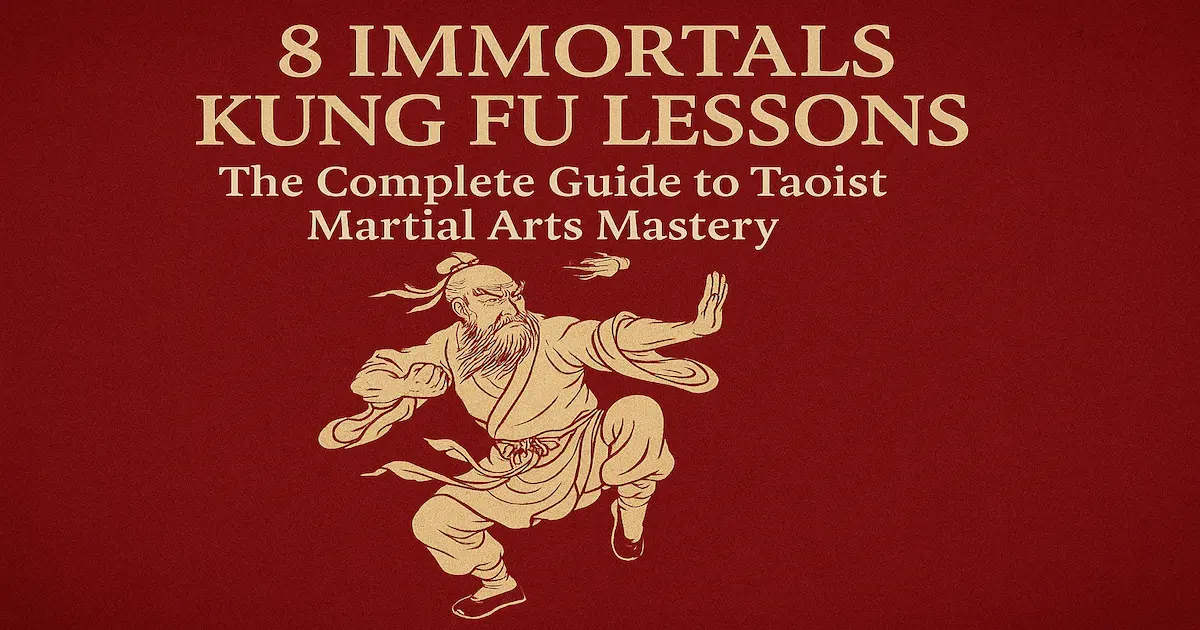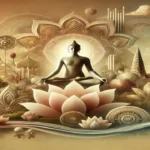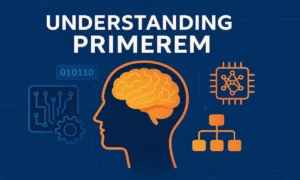8 Immortals Kung Fu lessons represent one of the most fascinating yet often overlooked branches of traditional Chinese martial arts.
Unlike more well-known styles like Shaolin Kung Fu or Tai Chi, this system offers a unique blend of combat techniques, Taoist philosophy, and mythological storytelling that makes it truly special.
At its core, it’s not just about fighting – it’s about cultivating a way of being that balances strength with wisdom, power with compassion.
The art takes its name from the legendary Ba Xian (Eight Immortals) of Chinese mythology, each of whom developed distinct fighting methods that reflected their personalities and spiritual journeys.
What makes 8 Immortals Kung Fu particularly valuable today is how it combines practical self-defense with deep internal development. The movements flow like water yet can strike like lightning, teaching practitioners to move through life with both grace and purpose.
The Legend of the Eight Immortals
To truly understand 8 Immortals Kung Fu lessons, we must first explore the rich mythology behind them. The Eight Immortals weren’t warriors in the traditional sense – they were scholars, healers, musicians, and eccentrics who achieved enlightenment through their unique paths.
Their stories were first compiled during the Tang and Song dynasties, becoming central figures in Taoist folklore and later inspiring martial arts masters to create fighting styles in their honor.
Each Immortal represents a different approach to overcoming life’s challenges. For instance, Lu Dongbin, the scholar immortal, teaches us that knowledge can be as sharp as any sword.
Li Tieguai, the crippled healer, shows how apparent weakness can conceal great strength. These aren’t just stories – they’re psychological archetypes that shape how practitioners approach both combat and daily life.
The legends tell us that true mastery comes not from brute force, but from understanding and working with the natural flow of energy in ourselves and our environment.
Taoist Philosophy in 8 Immortals Kung Fu
The philosophical foundation of 8 Immortals Kung Fu lessons comes straight from ancient Taoist principles. At its heart is the concept of Yin-Yang balance in combat – the understanding that soft can overcome hard, that yielding can defeat force.
This isn’t just theoretical; it’s built into every technique. When practicing He Xiangu’s evasive footwork or Zhongli Quan’s fan techniques, you’re learning to harmonize opposing energies in real time.
Breath control through Qi Gong and breathwork forms the invisible backbone of the art. Unlike external martial arts that focus solely on muscle power, 8 Immortals Kung Fu develops what masters call “internal strength” – the ability to generate power from proper alignment, relaxation, and breath coordination.
A typical training session might begin with standing meditation to cultivate Qi, then progress through forms that teach the body to move with the effortless efficiency of nature itself.
The Eight Immortals & Their Unique Styles
Let’s examine each Immortal’s contribution to this rich martial tradition in detail:
1. Lu Dongbin – The Sword of Wisdom
Lu Dongbin’s sword style emphasizes precision and mental clarity. Practitioners learn to cut through confusion both literally and metaphorically. The straight sword (Jian) techniques are among the most refined in Chinese martial arts, requiring exact body alignment and timing.
2. He Xiangu – The Grace of Adaptability
He Xiangu’s lotus-inspired movements teach evasion and redirection. Her style is particularly valuable for smaller practitioners, demonstrating how to use an opponent’s energy against them through subtle weight shifts and angular footwork.
3. Zhang Guolao – The Art of Misdirection
Zhang Guolao’s drunken-style techniques may appear chaotic, but they conceal brilliant strategy. This approach teaches how to break rhythm patterns and create openings where none seem to exist.
4. Li Tieguai – Strength Through Resilience
The iron crutch techniques develop incredible rooting power and unexpected striking angles from seemingly disadvantaged positions. Li’s methods prove that true strength comes from structure rather than muscle.
5. Lan Caihe – The Balance of Opposites
Lan’s flower basket style flows between masculine and feminine energies, teaching practitioners to move with complete body unity. The footwork patterns are particularly effective for multiple opponents.
6. Zhongli Quan – The Fan of Power
The iron fan techniques demonstrate how to deliver tremendous power through small, precise movements. The fan becomes both shield and weapon, embodying the Taoist principle of soft overcoming hard.
7. Han Xiangzi – The Flute’s Harmony
Han’s spiraling, flute-inspired movements teach circular defense and continuous flow. The techniques excel at close-range grappling and energy redirection.
8. Cao Guojiu – The Jade Discipline
Cao’s formal, restrained movements cultivate patience and precision. The jade tablet techniques emphasize perfect structure and internal power generation.
Core Techniques & Training Methods
Mastering 8 Immortals Kung Fu lessons requires a systematic approach that develops both external skill and internal awareness. Beginners typically start with:
- Zhan Zhuang (Standing Post) Meditation – Building root and Qi awareness through static poses
- Basic Stepping Patterns – Foundational footwork that appears in all eight styles
- Breath Coordination Drills – Learning to synchronize movement with abdominal breathing
Intermediate students progress to:
- Weapon Fundamentals – Starting with the fan or short staff before advancing to sword
- Form Sequences – Linking techniques into flowing patterns that tell each Immortal’s story
- Partner Sensitivity Drills – Developing tactile reflexes through pushing hands exercises
Advanced training includes:
- Combat Applications – Pressure testing techniques against resisting opponents
- Energy Projection – Learning to direct Qi for healing or martial purposes
- Philosophical Study – Deepening understanding of the Taoist principles behind each movement
A typical class might begin with 20 minutes of Qi Gong, followed by form practice, then conclude with partner drills. The progression mirrors the Taoist journey from cultivating self-awareness to harmonizing with others.
Benefits of Practicing 8 Immortals Kung Fu
The benefits of Eight Immortals martial arts extend far beyond the training hall:
Physical Benefits:
- Improves balance and coordination through complex stepping patterns
- Develops functional strength without bulk
- Enhances flexibility through full-range motions
- Boosts cardiovascular health via dynamic forms
Mental Benefits:
- Sharpens focus through precise movement requirements
- Reduces stress via meditative practice
- Enhances problem-solving through tactical training
- Builds discipline through gradual skill mastery
Spiritual Benefits:
- Deepens mind-body connection
- Cultivates emotional equilibrium
- Teaches principles of non-resistance
- Fosters self-awareness and growth
Modern research supports these benefits. A 2019 study published in the Journal of Alternative Medicine found that practitioners of similar internal arts showed significantly lower stress hormones and better cognitive function than control groups.
Adaptability for All Ages & Skill Levels
One of the most remarkable aspects of 8 Immortals Kung Fu lessons is their universal applicability. Children as young as 6 can begin with simplified versions of Lan Caihe’s flower basket forms, which develop coordination through playful movements.
The training naturally adapts to their growing bodies, preventing the over-specialization that plagues many youth sports programs.
For adults, the art offers a complete fitness system that evolves with your capabilities. A 40-year-old office worker might focus on He Xiangu’s posture-correcting techniques, while a 30-year-old athlete might emphasize Lu Dongbin’s explosive sword methods.
Seniors particularly benefit from Li Tieguai’s crutch techniques, which teach how to generate power from stable stances without straining joints. Many report improved balance and reduced arthritis pain after just a few months of practice.
Practical Applications Beyond Combat
While 8 Immortals Kung Fu contains effective self-defense methods, its real value lies in broader life applications:
In Business:
- Zhang Guolao’s strategic unpredictability aids negotiation
- Cao Guojiu’s discipline improves productivity
- Han Xiangzi’s harmony principles enhance teamwork
In Therapy:
- The flowing movements help trauma survivors reconnect with their bodies
- Breathwork techniques reduce anxiety symptoms
- Meditative aspects aid addiction recovery
In Performing Arts:
- Dancers incorporate the elegant footwork patterns
- Actors use the expressive qualities for stage presence
- Musicians apply the rhythmic principles
A notable case study involves a Seattle tech company that implemented 8 Immortals Kung Fu principles in their leadership training. After six months, teams reported 23% better conflict resolution and 15% higher creativity metrics.
8 Immortals Kung Fu in Modern Culture
The influence of 8 Immortals Kung Fu in movies and pop culture continues to grow. Recent appearances include:
- The Netflix series “Wu Assassins” featuring Li Tieguai’s crutch style
- The video game “Ghost of Tsushima” incorporating Lu Dongbin’s sword techniques
- Marvel’s Shang-Chi displaying Han Xiangzi’s flowing movements
Contemporary schools are innovating while preserving tradition. Some offer “Immortal Experience” workshops where students train in period costume. Others blend the art with modern fitness approaches, creating hybrid programs that appeal to younger generations.
Conclusion: Why Learn 8 Immortals Kung Fu Today?
In our fast-paced, disconnected world, 8 Immortals Kung Fu lessons offer something rare – a path to wholeness. They teach us to be strong yet flexible, disciplined yet spontaneous, powerful yet compassionate.
Whether you seek better health, practical self-defense, or deeper self-knowledge, this ancient system has never been more relevant. Visit: sahorizon.com for more articles.
As the old masters say: “The journey of a thousand miles begins with a single stance.” Your path starts now. Find a qualified instructor, commit to regular practice, and let the wisdom of the Eight Immortals guide your way.
Frequently Asked Questions About 8 Immortals Kung Fu
What is 8 Immortals Kung Fu?
8 Immortals Kung Fu is a traditional Taoist martial art based on the legends and fighting styles of China’s Eight Immortals (Ba Xian). It combines combat techniques with Qi cultivation, philosophical study, and meditative movement. Unlike many martial arts, it emphasizes adapting to situations rather than rigid forms, making it both practical for self-defense and valuable for personal growth.
How long does it take to master 8 Immortals Kung Fu?
Basic proficiency typically takes 1-2 years of consistent training, while true mastery is a lifelong journey. The art has layers of depth—physical techniques, energy work, and philosophical understanding—that reveal themselves gradually. Many instructors say it takes at least 5 years to grasp the fundamentals of all eight styles.
Can children or seniors practice 8 Immortals Kung Fu safely?
Yes! The art is highly adaptable. Children learn through playful versions of the forms that develop coordination and focus. Seniors often practice modified stances and Qi Gong elements that improve balance and joint health without strain. Many schools offer age-specific classes to ensure safe, appropriate training.
How is 8 Immortals Kung Fu different from Tai Chi?
While both are internal martial arts, 8 Immortals Kung Fu is more dynamic and varied. Tai Chi focuses on slow, continuous movements, while 8 Immortals training includes faster techniques, weapons work, and the distinct personalities of each Immortal’s style. It also places more emphasis on practical combat applications alongside meditation.
Do I need prior martial arts experience to start learning?
No experience is necessary. Beginners start with foundational stances, stepping patterns, and breathwork before progressing to more complex techniques. The system is designed to meet students at their current ability level and grow with them over time.












